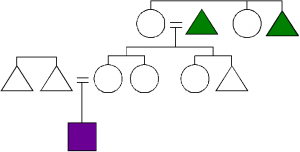![]()
![]()
![]()
![]()
![]()
![]()
jacāna
the feeling one has towards kin and people like kin, a strong feeling of good will towards them and of wanting to do good things for them; love.
![]()
![]()
![]()
![]()
![]()
![]()
ancāna
used to describe someone who induces this feeling in oneself; loved, beloved.
![]()
![]()
![]()
![]()
![]()
![]()
jacāna
the feeling one has towards kin and people like kin, a strong feeling of good will towards them and of wanting to do good things for them; love.
![]()
![]()
![]()
![]()
![]()
![]()
ancāna
used to describe someone who induces this feeling in oneself; loved, beloved.
![]()
![]()
![]()
![]()
![]()
![]()
![]()
![]()
jatēnnīke
a ceremony of joining.
ñi jatēnnīke ja pa jakīren riēnne;
You (two) are joined to the clan.
Note: OK, on to emotions and such next.
![]()
![]()
![]()
![]()
![]()
![]()
mēlīña
grandchild, one’s daughter’s child, any small child of any gender in one’s clan. The green squares in the diagram are the purple circle’s mēlīñi.
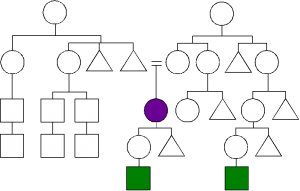
![]()
![]()
![]()
![]()
![]()
![]()
mamōīñ
a person’s male child, a son of one’s cousins, any male child of the next generation. So, the green triangles in the diagram as related to the purple square:

![]()
![]()
![]()
![]()
![]()
![]()
malāca
a person’s female child, a daughter of one’s cousins in the clan, any female child of the next generation in the clan. So the green circles in the diagram are the purple circle’s malāci.
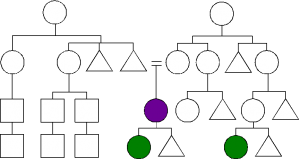
![]()
![]()
![]()
![]()
![]()
![]()
![]()
makāñīñ
one’s paternal nieces, nephews, anyone of a younger generation related to one’s father. The green squares (squares can be either gender) as related to the purple square in the diagram:
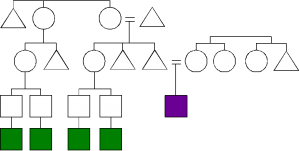
![]()
![]()
![]()
![]()
![]()
![]()
makāña
a cousin that is not within the clan, a child of one’s paternal relations. So, all the green circles and triangles are the purple square’s makāñi:
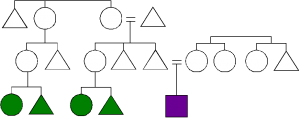
![]()
![]()
![]()
![]()
![]()
![]()
![]()
![]()
![]()
masōwaron
one’s paternal uncle, paternal grandfather, one’s father’s brother or father, any of one’s father’s male relatives of the same generation or older. One’s masōwaron is not part of one’s clan. Unlike other terms, masōwaroni can be in multiple generations. So, the green triangles are the purple square’s masōwaroni.
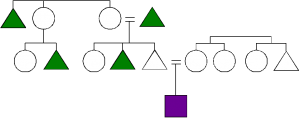
![]()
![]()
![]()
![]()
![]()
![]()
![]()
![]()
![]()
mapāranen
one’s paternal aunt, paternal grandmother, one’s father’s sister, one’s father’s mother, any of one’s father’s out-clan female relatives of the same generation or older. Unlike other terms, mapāranni can be in multiple generations. So, the green circles are the purple square’s mapāranni.
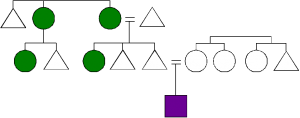
![]()
![]()
![]()
![]()
![]()
![]()
![]()
![]()
![]()
mawēsaron
one’s great uncle, one’s mother’s mother’s brother or husband, any male kin of one’s grandmother’s generation. Again, the green triangles in relation to the purple square:
